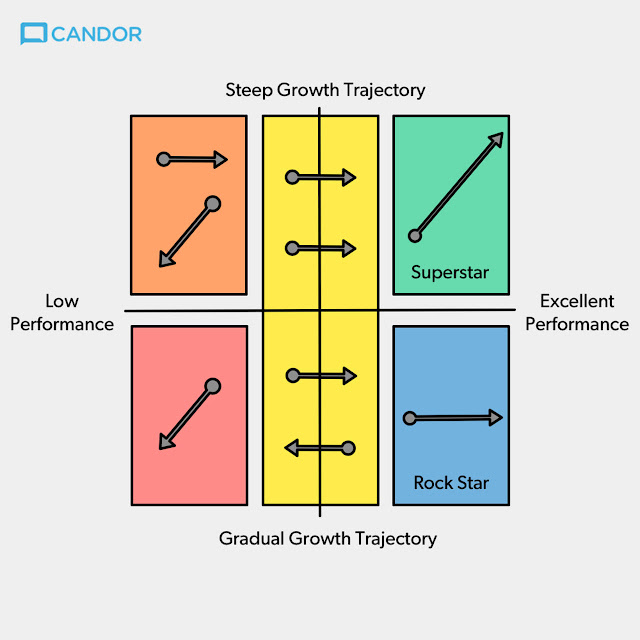@FirstRound Warning: This Is Not Your Grandfather’s Talent Planning | First Round Review
How to Tell Your Stars Apart
There’s a lot of jargon to describe superior performers on teams: 10x engineer, sales wizard, growth ninja. “Superstar” and “rock star” are also thrown about liberally, but Scott is on a mission to reclaim them —not as labels for people — but to understand what mode people are in at any given point in time. …
Here’s what she meant:
•Superstar mode: the people on your team who are going to change everything; responsible for Schumpeterian change; a force —and source— of growth on a team.
•Rock star mode: the people on your team who don’t want their boss’ job; very talented at their role and will keep doing and digging into it for years if a boss doesn’t screw it up; a force —and source— of excellence and stability on a team.
People in superstar mode want a world they can change. Those in rock star mode seek a world they can stabilize. You’ll need both.
“But often when we think about so called ‘talent planning’ — we use the word ‘potential.’ ‘Potential’ is exactly the wrong word.”
The problem with “potential” is that when you mark someone as low-potential, you devalue your rock stars off the bat. “Instead, use the word growth trajectory. There’s nothing good or bad about a steep growth trajectory or a gradual growth trajectory. It just references different phases in our career,” says Scott. “When you look at your team this way, you identify five different modes that people can be in. They can be in superstar mode. They can be in rock star mode. Or on various paths to reaching or recessing from those modes.”
Before you start to write your team into these buckets, let this one lesson sink in: don’t use a permanent marker. “I can’t stress this enough for managers. There are no permanent markers. Don’t write people’s name in a box and leave them there,” says Scott. “Don’t use this as a label for individuals. Use this to understand what a person wants at a moment in time. Remember, these are modes, not personality labels. Use this to understand what the dreams are of the people who work for you and to help them take a step in the direction of their dreams, not your dreams. Their ambitions, not your ambitions.”
Superstar mode.
For the people who are in superstar mode — those who are going to drive growth on your team — what you want to offer them is new challenges. You want to keep them learning. The last thing you want to do is squash them.
…take note of the lifetime of superstars. “Make sure you identify a successor because you often can’t retain your superstars. They’re going to leave you better than they found you. Make the most of them while you get them, but don’t assume they are going to stick around forever because they often don’t,” says Scott. “Whatever you do, don’t confuse management and growth. Don’t automatically manager-track the people on a super steep growth trajectory. Often, especially for engineers, the last thing in the world they want to do is be a manager, but that doesn’t mean that they are not on a super steep growth trajectory. Make sure you’re giving the right kinds of challenges to the right people.”
Rock star mode.
People in rock star mode want a pasture, not a runway. You’re not giving them a route to take off, but making space to settle into their work. What they need is freedom to do their superb work, not a path to promotion, which may distract them.
The choice of the manager here goes beyond just one rock star’s role. “Don’t create an organization that is so obsessed by promotion and status that it feels humiliating for the rock stars to stick around,” says Scott. “Set them up as internal experts. Your rock stars love their craft and are great at it. They’re better than anybody in the company and they can help bring the people in the middle along. They can help turn good performance into excellent performance from others. If they have an interest in teaching, by all means, let them teach.”
…give them respect.
The bottom line is that it works out, but only if you respect your rock stars — and keenly balance your need for growth with stability on your team. Early-stage and high-growth startups will over-index on superstars, but they’ll need to add in rock stars as they grow, guaranteed.
Middle performance column
-Low performance, steep trajectory mode. Those in the upper left quadrant are people who ought to be doing great but are failing for some reason.
-Low performance, gradual growth trajectory mode. There will be people who aren’t doing well and aren’t getting better.
The Best Type of Manager For High-Performers
-One of the biggest mistakes that managers make with the people who are doing the best on their team is just get out of their way. … It means approaching their work with curiosity and with an aim to be equals in discussing it.
If you’re not a thought partner, you may easily fall into two other buckets when you manage high-performers:
·the absentee manager
·micro-manager
The Start of It All
Building a kickass team starts with something incredibly simple, not a big company process, but something you already know how to do: get to know people at a fundamental human level. This is one of the most important — and also the most enjoyable — parts of your job as a leader. Understanding what kind of growth trajectory each person on your team wants to be on, and what motivates them at work, is a concrete first step.
“Having three different career conversations — life story, dreams, and career action plan — is a much better course of action. It’ll help you decode who’s in superstar mode, rock star mode and — most critically — who is changing modes,”


